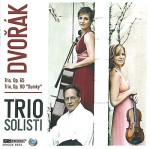Column Name
Title
Dvorak: Two Piano Trios. Trio Solisti. (Bridge 9393)
Body
Dvorak’s Third and Fourth Piano Trios are among his finest works—sprightly, beautifully constructed, and offering a wide emotional range—and in this recording, they receive outstanding readings from Trio Solisti, which was founded in 2001. Cellist Alexis Pia Gerlach (B.M. ’95) and pianist Jon Klibonoff (M.M. ’82, D.M.A. ’88) join violinist Maria Bachmann to lavish attention on these beloved pieces. For fans of these two trios, this will be one of the best recordings of the year.
The stormy opening of the Third Trio (Op. 65, in F minor) shows off the group’s chemistry as each member takes the melodic line in turn before the whirlwind final bars. Klibonoff is a model of exactitude, leading off the Allegretto grazioso, a scherzo with a moving, flowing central interlude. Gerlach and Bachmann have the spotlight in the gorgeous (and deeply moving) Poco Adagio. As in some works of Brahms—whom Dvorak greatly admired—the melodic line is heartbreaking, and it’s worth noting that while working on the piece, Dvorak was mourning the death of his mother. But the mood brightens once again in the crisp phrases of the finale, with a dazzling Czech furiant at its core.
Equally compelling is the popular “Dumky” Trio (Op. 90, in E minor), artfully constructed from six dumky (the plural of dumka, or a lament) in contrasting keys. The six sections masterfully combine slow and fast elements—I particularly like the second and third, but each has its own inspiration—and the group’s expert balance, navigating the composer’s constantly shifting rhythms, shows how thoroughly the three musicians have internalized the score. The fizzy folk rhythms are infectious and done with great precision, but the group’s sensitivity in the more reflective, slower passages is also impressive.
Once again, engineer Adam Abeshouse—popular with so many recording artists—works his magic at the SUNY Purchase concert hall (Theater C), giving every bow stroke and piano tone a satisfying realism.
John Adams: Fellow Traveler—The Complete String Quartet Works. Attacca Quartet. (Azica Records ACD-71280)
 John Adams may be best known for his operas and orchestral works, but here the Attacca Quartet makes a sizzling recording debut with his complete works for string quartet. The Attacca, which formed at Juilliard in 2003 and was the graduate resident string quartet from 2011 to 2013, is made up of violinists Amy Schroeder (B.M. ’06, M.M. ’08, Artist Diploma ’13) and Keiko Tokunaga (Pre-College ’03; B.M. ’07, M.M. ’08, Artist Diploma ’13); violist Luke Fleming (M.M. ’07, D.M.A. ’12, Artist Diploma ’13); and cellist Andrew Yee (B.M. ’06, M.M. ’08, Artist Diploma ’13).
John Adams may be best known for his operas and orchestral works, but here the Attacca Quartet makes a sizzling recording debut with his complete works for string quartet. The Attacca, which formed at Juilliard in 2003 and was the graduate resident string quartet from 2011 to 2013, is made up of violinists Amy Schroeder (B.M. ’06, M.M. ’08, Artist Diploma ’13) and Keiko Tokunaga (Pre-College ’03; B.M. ’07, M.M. ’08, Artist Diploma ’13); violist Luke Fleming (M.M. ’07, D.M.A. ’12, Artist Diploma ’13); and cellist Andrew Yee (B.M. ’06, M.M. ’08, Artist Diploma ’13).
The CD begins with John’s Book of Alleged Dances (1994), which has 10 quirky sections, one of which wins the award for title of the month: “Toot Nipple.” As Fleming explains in the liner notes, this is a reference to a character in Annie Proulx’s novel Postcards who was “a terror on the dance floor.” Many listeners’ feet will no doubt be tapping along with the movement’s buzzing ferocity.
In six of the 10 movements (such as the infectious “Hammer and Chisel” and “Dogjam”), a prerecorded rhythm track (samples of prepared piano sounds) creates the driving beat often associated with the composer. But all 10 are rhythmically eclectic and difficult. The final track, “Judah to Ocean,” is a reference to a San Francisco streetcar line, and it closes the set with vivacious energy.
With similar drive, the players attack Adams’s 2008 String Quartet, which they have performed around the world to great acclaim. (Incidentally, the St. Lawrence String Quartet gave the work’s premiere at Juilliard as part of the 2009 Focus! festival.) The first movement, almost 20 minutes long, shows off the Attacca’s tonal palette: airy harmonics, wiry glissandos, woody spiccato passages—and spot-on intonation. In the second movement, introductory octave leaps soon fan out in all directions to form a frantic, bristling scherzo.
The disc closes with the first recording of Fellow Traveler (2007), a rousing 50th-birthday gift from Adams to the director Peter Sellars. Bruce Egre is the sound engineer (working at the American Academy of Arts and Letters), and he ensures that each click, knock, and slide is delectably audible.





